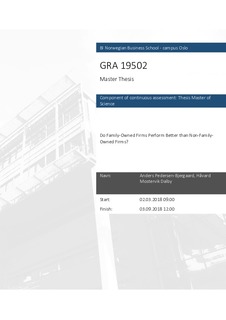Do Family-Owned Firms Perform Better than Non-Family-Owned Firms?
Master thesis
Permanent lenke
http://hdl.handle.net/11250/2577167Utgivelsesdato
2018Metadata
Vis full innførselSamlinger
- Master of Science [1621]
Sammendrag
This thesis examines the performance of family-owned and non-family-owned
firms in Norway from 2000-2015. The performance differences are compared using
return on assets (ROA) as the indicator of firm performance. The thesis also takes
a closer look at performance in family and non-family firms within five different
industries: Retail, shipping, architecture, financial services and IT.
The research is mainly based on OLS panel regression, where the analysis is divided
into four models. To verify the data robustness of the results from the main
specification, two additional robustness checks using the generalized method of
moments (GMM) and panel OLS controlling for industry specific effects are
performed.
On average, family-owned companies tend to perform better than non-familyowned
companies. From the four regression models representing the main
specification, the results show that family ownership does not affect firm
performance for the population as a whole. The robustness check incorporating
GMM also confirms this. The results suggest that the family-owned companies tend
to perform better because they have smaller boards and a higher degree of inside
power, rather than the family ownership itself. Unlike previous research, this thesis
also looks at differences within industries. The results presented find that family
ownership has a positive, significant effect on firm performance within the
architectural industry. For companies within shipping, this relationship is the
opposite, and family ownership is shown to have a significant, adverse effect on
firm performance. This contradicts what we found when analysing the population
as a whole.
Indeed, our results indicate that the effect of family ownership on firm performance
relies on the industry which the firm is located within. The results presented also
suggests that the reason for these results may be due to different industries being
exposed inversely to agency conflicts. Compared to previous studies done on family
firms in Norway, this thesis neither rejects nor confirms previous research and is
best seen as complementary.
Beskrivelse
Masteroppgave(MSc) in Master of Science in Business, Finance - Handelshøyskolen BI, 2018
